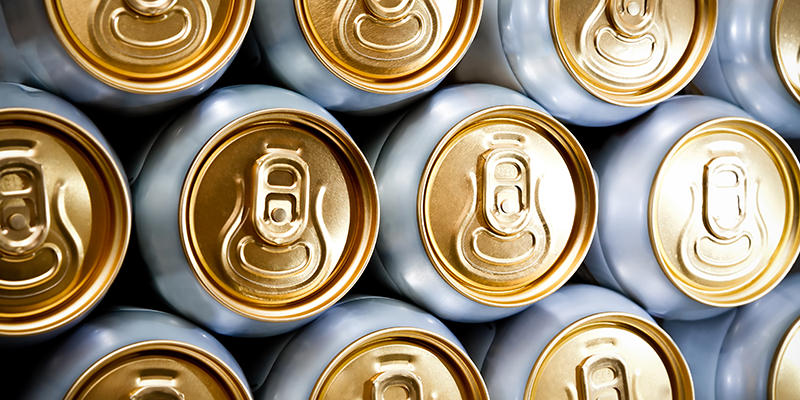Over the past decade there has been a craft beer boom in America. One can find craft beer at almost any bar across the country, and the options only continue to grow. At this point craft beer already represents 10% of the American beer market, and the trend suggests the number is rapidly increasing. In fact, the Brewers Association, America’s most notable craft brew trade organization, has set a goal for craft beer to claim 20% market share by 2020. That suggests the industry will grow to double what it is now in only four years. With roughly two craft breweries opening every day in the United States, the Brewers Association estimate doesn’t seem unrealistic and the recent growth is undeniably a boom. But all this growth comes at a cost — an aluminum can shortage and a resulting aluminum war.
A microbrewery making craft beer can only become the lucrative business it strives to be by packaging its beer and selling it for consumption outside of the brewery. Obviously it can make money by selling beer inside the brewery fresh off the tap, but it can only entertain as many customers as its space holds. Thus, when a microbrewery creates a beer that is deemed especially delicious, it’s bound to package it, and when this decision is made there are two options: glass or can.
These days, the packaging decision is predominantly can. In 2006 cans accounted for 48.3% of the beer packaging market and bottles accounted for 41.9%. Six years later, in 2012, the margin between the two was significantly larger, with cans constituting 53.2% of the market and bottles 36.5%. A more specific example that demonstrates this trend is that Whole Foods, which says it is one of the largest – if not the largest – craft beer retailers in the country, saw a 30% increase in canned beer sales in 2012-2013. The craft beer boom is one thing, but within it we are definitely seeing an aluminum can boom as well.
Why is this the case? One may be lead to think it’s because cans are scientifically better for beer. The case is frequently made that when beer is packaged in a glass bottle it is exposed to sun and other outside light that can compromise and destroy the organic compounds that make beer taste good. It’s a solid argument, but it isn’t considered fact because while some beer experts say they believe this is the case others dispute the claim.
So we don’t know if cans are necessarily better than bottles for the long-term health of beer, but there are two things we do know about cans versus bottles. The first thing is that aluminum cans are better for the environment than glass bottles. In order to recycle glass it needs to be melted, which requires significantly more energy than it takes to recycle aluminum. The second is that cans are simply more convenient to use. Glass can break when dropped and, as we all know, it can be a huge hassle to clean up broken glass. Aluminum cans can explode if dropped, but they’ll only leave a messy puddle of beer to clean up afterward. Cans are also easier to move since aluminum is lighter than glass, and they’re easier to store since their shape allows them to be stacked on top of each other. All these factors together create a pretty solid reason for microbreweries to choose aluminum cans over glass bottles when packaging their golden products.
If cans used to be indicative of a lower quality beer, that’s obviously no longer the case. Great beer can be packaged in aluminum cans and people will pay good money for it, and microbreweries have embraced the trend. But the metallic progression has one gigantic, unintended consequence: a shortage of aluminum cans.
The paradigm shift in the beer packaging market has made it so that cans are increasingly hard to get. According to Josh Stylman, co-founder and managing partner at Brooklyn-based microbrewery Threes Brewing, “Big companies like Budweiser have their own resources and factories so they can run the table on aluminum cans. Even if we had our own canning line, we would have a hard time getting cans.” Stylman is essentially saying that canning lines, which take beer from vats and put it into cans, are first of all expensive. And second of all, even if a microbrewery could afford its own canning line, it wouldn’t be able to run it because there aren’t enough aluminum cans for everyone in the beer market. All the available cans are currently bought up by big beer companies like AB-InBev, which outbid microbreweries and leave them in the dust.
This all alludes to a huge issue for microbreweries: they want to package in cans but cans are hard to obtain. You would think that the answer would be to simply move back to bottles, right? They get the job done and they used to be considered higher quality. That may be the simple answer, but the smart answer is to outsource the canning. What’s happening is that microbreweries are outsourcing it to mobile canners. According to Stylman, it’s pretty simple. He says, “The company drives a rig, shows up for the day, parks it next to the brewing tank, puts all of our beer in cans, and then they take off.”
Outsourcing to a company solely concerned with obtaining aluminum cans and filling them with beer is the only answer for microbreweries. Canning line businesses allocate a hefty part of their resources to simply obtaining aluminum cans. Although big beer companies have more resources than canning line companies, they have a lot more to focus on than just obtaining cans. And since a canning line business represents multiple microbreweries, it essentially allows microbreweries to come together and team up against the big hitters in the beer market.
If the aluminum can shortage gets worse it will be interesting to see who shifts back to bottles first. Will it be the big hitters or the microbreweries? Obviously, no one knows what the future has in store for these opposing poles of the beer spectrum, but one thing is certain, and it’s that canning line services are the only hope for microbreweries caught in aluminum warfare.

